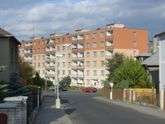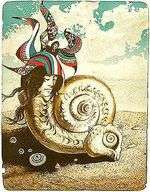Kadaň
| Kadaň | |||
| Town | |||
 | |||
|
|||
| Country | Czech Republic | ||
|---|---|---|---|
| Region | Ústí nad Labem | ||
| District | Chomutov | ||
| Commune | Kadaň | ||
| River | Ohře | ||
| Elevation | 300 m (984 ft) | ||
| Coordinates | CZ 50°22′34″N 13°16′17″E / 50.37611°N 13.27139°ECoordinates: CZ 50°22′34″N 13°16′17″E / 50.37611°N 13.27139°E | ||
| Area | 65.62 km2 (25.34 sq mi) | ||
| Population | 18,759 (2006-08-28) | ||
| Density | 286/km2 (741/sq mi) | ||
| First mentioned | 1183 | ||
| Mayor | Jiří Kulhánek | ||
| Timezone | CET (UTC+1) | ||
| - summer (DST) | CEST (UTC+2) | ||
| Postal code | 432 01 | ||
  Location in the Czech Republic | |||
 Location in Chomutov District | |||
| Wikimedia Commons: Kadaň | |||
| Statistics: statnisprava.cz | |||
| Website: www.mesto-kadan.cz | |||
Kadaň (Czech pronunciation: [ˈkadaɲ]; German: Kaaden), is a city in the Ústí nad Labem Region of the Czech Republic. The city lies on the banks of the river Ohře. Although it is situated in an industrial part of the Czech Republic there is no major industry within the city and people usually work in offices or have to commute. There are two large power plants nearby (Tušimice and Prunéřov). Kadaň is a tourist centre with highlights being the Franciscan Monastery and the historical square with late Gothic Town Hall Tower. It is also a town with the narrowest lane in the Czech Republic - Katova ulička with only 66.1 cm.
History
Early history until the Thirty Years' War
There are legends accrediting the beginnings of the town to Celtic tribes. In the 1st century A.D. Germanic tribes came, but moved on in the great Germanic migration to the west. In the 6 th century the country was settled by Slavs. Some talk about a castle on Úhošť hill that might have been called Wogastisburg where a battle between Franks and Slavs occurred in 631. The battle of Canburg in 805 is also often mentioned in connection with the town, but is a mistake because locality of this name (Canburg - Kanina) is in Middle Bohemia.
The first written record is, though, of the end of the 12th century - the Czech prince granted the "market town" of Kadaň to the Knights of St. John. Slavic rulers called German settlers into the country, offering them freedom but gaining taxes at the same time. The Knights Hospitaller built the first church in Kadaň - St. John the Baptist - which still stands in the part of town called Hospitaller Suburb, but is now in the Baroque style. In the 13th century, the town was promoted to a "Royal City". It began to thrive and a new town was built on the heights above the river, with a castle and Franciscan monastery. There was a big fire in 1362. However, Emperor Charles IV who twice visited the city (1367 and 1374) granted it several municipal rights (home rule, a vineyard, and an annual market) that made it flourish again. The reign of Wenceslaus IV (Václav IV) produced the skilled clockmaker Mikuláš of Kadaň (Mikuláš z Kadaně), who, together with mathematician and astronomer Jan Šindel, designed the Prague Orloj.
The 15th century brought a new dimension to the history of Kadaň: the town and castle often used to be pledged to royal creditors. At the end of the rule of George of Poděbrady first the town and later the castle was captured by Jan Hasištejnský z Lobkovic (John of Lobkowicz and Hassenstein), who seemed to see Kadaň as a suitable capital for his dependent territories. The establishment and construction of the monastery of the Franciscans of strict observance, built as a family burial-place and later a pardon place of Fourteen Holy Helpers, may reflect his ambitions for the town. Jan Hasištejnský died in 1517 and is buried in the Church of Fourteen Holy Helpers. His tomb is still on display in the Church, now part of the municipal museum. The same year saw the beginning of the Reformation in Germany, which had an immediate impact on the atmosphere in German speaking Kadaň. In 1534, "Kadaň religious peace" was negotiated here between Württemberg Protestants and Ferdinand I, Holy Roman Emperor for the Catholic side. In the Thirty Years' War during the next century, Kadaň suffered from fires and plundering by various armies on their way to the battlefields of Bohemia. After the war, the formerly Czech-German town became a monolingual German domain.
The Age of Enlightenment until the 19th century

During the Silesian Wars Kadaň was a foothold for the withdrawing French army that fortified in the Franciscan monastery and was besieged by Hungarian and Croatian units of the Austrian army. The door of the monastery church still shows the bullet holes from that battle on October 14, 1742. The town caught fire in 1746, providing a great opportunity for Kadaň's "Christopher Wren" - Johann Christoph Kosch. He built many Baroque buildings, including the Church of the Elevation of the Holy Cross, the Church of the Holy Family and the monastery of the Order of St. Elisabeth. The Castle of Kadaň was rebuilt to serve as a barracks in the time of Maria Theresa of Austria. Her son Joseph II visited Kadaň in 1779. Joseph's reforms also affected town life. The monastery of Minorites was closed and thereafter became the premises of the first Grammar School under control of the Piarists from 1803 to 1823. 1788 saw the inauguration of the town municipal council. Jakob Marzel Sternberger was its first Mayor and held office until 1822. His great-grandson Jacob Sternberger emigrated to the U.S.A. in 1850 as part of the first wave of European immigrants of that time (Max Kade Institute).
The last great fire damaged the town in 1811 and since then, the historic centre has retained its pattern. After the Revolution of 1848 the letdown town became a district centre. The institute of the district town lasted in Kadaň for 110 years when it was affiliated with Chomutov district. In the second half of the 19th century homeland study activities developed and a number of institutions, clubs and societies were established. The national composition of the Kadaň population was very explicit - over 90% German and only 3% Czech, with a Jewish community as well.
20th century
At the start of the 20th century, the "Society of Friends of the Museum in Kaaden" decided to document the towns' history by opening a museum.
In the final weeks of World War I, Czechoslovakia was established on 28 October 1918, its Czech, Moravian and Silesian component having been defined by the historic borders of the Czech (Bohemian) kingdom. However, most of the German border population, was not enthusiastic about becoming part of a new republic with a clearly Slavonic definition. Instead, four regional self-governed states emerged along the borderland, according to the right for self determination guaranteed by Woodrow Wilson in no. 10 of his Fourteen Points. Kaaden, (Kadaň in Czech), declared itself part of German Bohemia. On 4 March 1919, the first assembly of the German Austrian parliament was the occasion for both peaceful and violent demonstrations in the mostly German-populated border cities. In Kadaň, the curfew and martial law was declared and the Czechoslovak military forces were sent in. The demonstration in Kadaň for self determination was the bloodiest. According to Swiss Neue Zürcher Zeitung report of 7 March 1919, 17 persons were killed, 30 badly wounded, and 80 wounded there. Over all, 25 victims were buried in a memorial grave at the central cemetery. It was restored after the fall of communism in 1989.
After the Munich Agreement in later September 1938, Kaaden became part of Reichsgau Sudetenland. The local Czech people were forced to move to central Czechoslovakia, the remaining ones and the Jewish community was strongly oppressed. The synagogue was burnt down during the Kristallnacht of November 9, 1939. According to Beneš decrees, after the Second World War, all of the German population was transferred (Flight and expulsion of Germans from Czechoslovakia during and after World War II), and the area was re-settled by Czech people, many without roots in this region.

From the 1950s, new prefabricated housing estates were built that reached the outer parts of the historical conurbation in the 1960s and 70s. This expansion was necessary because many people had moved in to get jobs in the region's thriving mining and electrical industries. The historical monuments were dilapidated and uncared-for. Before 1989 some parts of the historical centre were intended to be replaced by modern housing. Fortunately the Velvet Revolution changed the trend of development in the town and brought about a change in attitudes towards the cultural values of the past. The historical heart of Kadaň began to be repaired and after 15 years it has become a pearl of the region. There is now a new site on the bank of the Ohře River being planned and projected- Maxipes Fík Embankment with a lot of attractions both for children and adults. The town has been turning to be a tourist centre of the predominantly industrial region. The only drawback for tourism is the lack of a higher-capacity hotel in the town.
Places of interest
- Franciscan Monastery (museum)
- Town Hall Tower
- The Castle
- The Old Square
- Holy Tower
- Barbican
- Lookout Tower on Svatý kopeček (Holy Hill)
Galleries

- Městská galerie Josefa Lieslera ("pod věží" - under the tower)
- Městská galerie Karla Havlíčka ("na hradě" - in the castle)
- Galerie U Netopýra also called Kisza Gallery, is one of the largest private galleries with permanent exhibition in Central Europe
- Galerie U Adama (Jitka Gavendová and František Vlček)
- Galerie Na půdě - "on the attic" (of the Franciscan Monastery)
- Pictures and photographs for sale are usually in a lot of local restaurants and boarding houses
Annual events
- Emperor's Day (on last August Sunday, takes place on the square with a lot of attractions)
- Maxipes Fík Birthday
- Kirwitzer Astronomical Day
- Old Czech Carnival
- Franciscan Summer
- Vine Harvest Festival
- Vysmáté léto - Summer Rock Fest
- Nativity Play
- Passion of Christ Play
Education



Kadaň is home to several secondary schools with a long history. The oldest of them is the Gymnasium that was established in 1803 with 99 students and continued under the control of the Piarists until 1823. The seat of the old Gymnasium was a former Minorites Monastery (different from the Franciscan Monastery) near the square in a building which is now residence of the Regional Archives. The institute of Gymnasium was then reestablished in 1872 in a new building. The Gymnasium was again closed in 1951 and the new Industrial School moved to the building. It is still there today. A new Gymnasium was established in 1968 and has remained on the same premises since 1978. The Industrial School specialized at first on mining (because of the lignite and uranium mines in the surroundings), however since 1957 it has been specialized on building and finally in 2001 it added Commercial Academy to its educational program so now it is called Industrial Building School and Commercial Academy. The Agriculture School (now SOŠS a SOU Amos) was established in 1862 as so-called Ackerbauschule. In front of the building there are valuable statues of Albrecht Daniel Thaer and Justus von Liebig (restored in 2003). The teaching in all the schools was in German language until 1945. There are 4 Elementary Schools in Kadaň and a school for handicapped children.
Personalities
History
- Peter Georg Niger (Schwartz) (1434 - 1481 or 1484) - theologian
- Jan Hasištejnský z Lobkovic (1450 - 1517) - traveller, politician and writer
- Petr Štěrba ze Štěrbic (1517/18-1591) - scriber and translator
- Jan Sandel - translator from German (Wenceslaus Hájek's Bohemian Chronicle, 1543)
- Wenceslas (Václav) Pantaleon Kirwitzer (1588 - 1626 Macau) - astronomer
- Wilhelm Nigrinus (Schwartz) (1588 - 1638) (de:Wilhelm Nigrinus), ethnologist
- Theodor Innitzer (1875 - 1955) - cardinal archbishop of Vienna
- Hans Zeisel (1905 - 1992 Chicago), sociologist and economist
- Petr Klíma (1964 born to Kadaň parents in Chomutov hospital), ice hockey player, Stanley Cup winner (1990, Edmonton Oilers)
Music
- Edward Goll (1884 - 1949, Melbourne, Australia), pianist and music teacher
Art

- Karel Havlíček (1907 - 1988)
- Josef Liesler (1912 Vidolice u Kadaně - August 6, 2005 Prague)
- Josef Kokeš (1906 - 1967)
- Rudolf Koblic (1933 - 2003)
- Herbert Kisza (*1943)
- Vojtěch Kraus
- František Vlček (*1947)
- Jitka Gavendová (*1946)
- Jitka Křivancová
- Pavel Wolf
- Dalibor Vajnar
- Kryštof Kisza
- Margo Paran (*1946) - an Israel artist and poet born in Kadaň
Theatre
- Josef Dvořák
- Kladivadlo
- Navenek
Literature
- Václav Řezáč
- Rudolf Čechura
Churches
There are churches and chapels of four Christian denominations: Roman Catholic Church, Czechoslovak Hussite Church, Evangelical Church of Czech Brethren and Orthodox Church. Roman Catholic Parish Church of the Elevation of the Holy Cross is situated in the square.
Parks and urban vegetation

Kadaň is situated at the edges of Doupov Mountains with mixed forests and Ore Mountains with coniferous stand. There were three major parks in the 19th century enlarging town. The Municipal park - now Smetanovy sady - was founded by a Kadaň inhabitant and future Mayor Peter Prinzl in 1852. Landscape park was also established on the rocks over the Ohře river next to the Franciscan monastery. A new organisation Anpflanzungs- und Verschönerungsverein Kaaden concentrated its energy on park layout for so-called Svatá hora or Svatý kopeček - Holy Hill that was called "holy" (heiliger berg since 1541) for its position above the holy pilgrimage monastery. The hill with abandoned rock vineyards became an English park with a lot of viewpoints, arbours and benches at the turn of the 20th century. Jaroslav Havlíček wrote in his novel "Vlčí kůže" about Svatá hora that it was a place for romantic walks of young couples. The park the area around was also referred to as Sommerfrische Kaaden - Kadaň summer resort. It was, however, not cared for in the times of World War II and Communists after 1948 left the park to be completely devastated and overgrown. However, the socialist planners projected the new residential areas with a lot of greenery inside. A new large park came to existence on the other side of the town on the left bank of Bystřice stream - now Rooseveltovy sady.
Interesting facts
- A Swiss-French writer Benjamin Constant set a part of his famous novel Adolphe (1816) in Kadaň, referring to it as Caden, petite ville de la Bohême.
- Václav Vanya from Kadaň Švejk Restaurant U Věžičky won the national Pilsner Urquell Master Bartender competition 2008.[1]
- There is a dive bar named Kadaň located in San Diego, California.
Environs and tips to visit
- Hasištejn Castle
- Úhošť hill
- Klášterec nad Ohří
- Krásný Dvůr
- ZOOpark Chomutov
- Nechranice reservoir
- Egerberk Castle
- Šumburk Castle
- Hauenštejn Castle / Horní Hrad
- Karlovy Vary - 44 km
International relations
Twin towns — Sister cities
Kadaň is twinned with:
References
- ↑ (Czech)
External links
| Wikimedia Commons has media related to Kadaň. |

